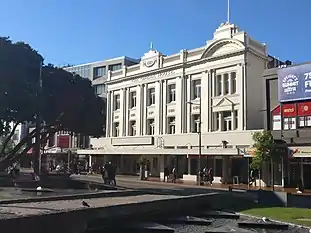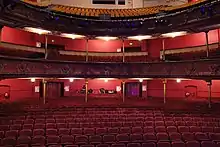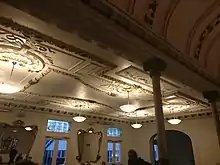Opera House, Wellington
The Opera House is a proscenium theatre in Wellington, New Zealand, located on Manners Street opposite Te Aro Park.
Previously: State Opera House, The Grand Opera House | |
 The Opera House on Manners Street, Wellington. | |
| Address | 111–113 Manners Street Wellington New Zealand |
|---|---|
| Coordinates | 41.2915°S 174.7778°E |
| Designation | NZHPT classification I |
| Type | Opera House |
| Capacity | 1,381 |
| Construction | |
| Opened | 1914 |
| Architect | William Pitt |
| Website | |
| Venues Wellington: The Opera House | |
| Designated | 27 June 1985 |
| Reference no. | 1432 |
History
The present Opera House replaced earlier buildings on Manners Street. The Imperial Opera House opened in 1878, but burnt down a year later.[1][2]

Construction work on the present building began in 1911. It was named The Grand Opera House in May 1913 with a plan to open early on Boxing Night that year.[3] The principal architect William Pitt was based in Melbourne, Australia, and much of the work was overseen by Wellington architect Albert Liddy.[4] The opera house finally opened on Easter Saturday of 12 April 1914 to an evening performance by the American Burlesque Company, with a full seating capacity of 2141 in three levels of stalls, dress circle and gallery, including 50 box seats.[5] The original seating upholstery was made and installed by the Wellington company Kirkcaldie & Stains, and the interior features fine plaster mouldings and an ornate dome.[3] The building was designed with brick masonry outer walls with wooden floors and a timber-framed roof.
In 1977 it was restored with funding from the New Zealand insurance company State Insurance, and for many years it was known as the State Opera House.[6]

In the 1990s and early 2000s the building was operated by the St James Theatre Trust, which ran the nearby St James Theatre. In July 2011 Positively Wellington Venues, an integration between the Wellington Convention Centre and the St James Theatre Trust, began managing the theatre under the new name of The Opera House along with five other venues in the capital city. In October 2012 it was announced that the Opera House was an earthquake risk and would possibly have to close.[7] By the end of 2016, funding from Wellington City Council and the Performing Arts Foundation of Wellington enabled the building to be strengthened and restored to sufficient code to continue to be open to the public.[8] The refit also included an award-winning restoration of its original interior features, by a local architect and 14 painters and artists.[9]
The Opera House was used for the theatre scenes in Peter Jackson's 2005 film King Kong.[10]
References
- Kernohoran, David, Wellington's Old Buildings, Victoria University Press, 1994, ISBN 0-86473-267-8 (page 131)
- "Opera House". New Zealand Heritage List/Rārangi Kōrero. Heritage New Zealand.
- "Town News". New Zealand Mail. No. 315. 4 May 1878. p. 13. Retrieved 14 September 2019 – via Papers Past.
- "Great fire in the city". Evening Post. Vol. XVII, no. 542. 21 June 1879. p. 5. Retrieved 14 September 2019 – via Papers Past.
- "New Theatre Named". Dominion. Vol. 6, no. 1754. 20 May 1913. Retrieved 21 December 2018 – via Papers Past.
- "Grand Opera House". Evening Post. Vol. 87, no. 61. 13 March 1914. Retrieved 21 December 2018 – via Papers Past.
- "The Stage". Wairarapa Daily Times. Vol. 66, no. 11927. 14 March 1914. Retrieved 21 December 2018 – via Papers Past.
- McConnell, Rhiannon (10 February 2016). "Opera House Lane's dark days". The Wellingtonian. Retrieved 21 December 2018.
- Jackman, Amy (11 October 2012). "Opera House may close". The Wellingtonian. Fairfax Media. Retrieved 26 June 2018.
- Jackman, Amy (23 October 2014). "Quake risk building's $1m upgrade". The Wellingtonian. Retrieved 21 December 2018.
- Flahive, Brad (10 October 2016). "Wellington Opera House restoration recognised with award for its use of colour". Stuff. Retrieved 21 December 2018.
- Wellington Regional Economic Development Agency. "King Kong – where versatility was key". wellingtonnz.com. Retrieved 26 June 2018.